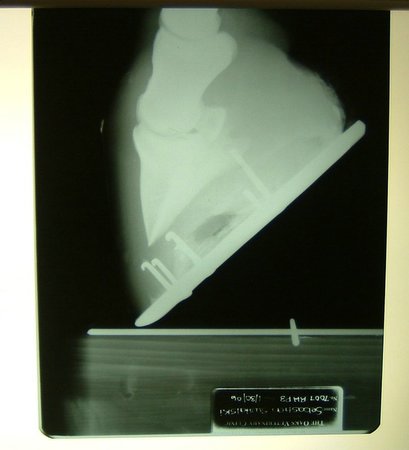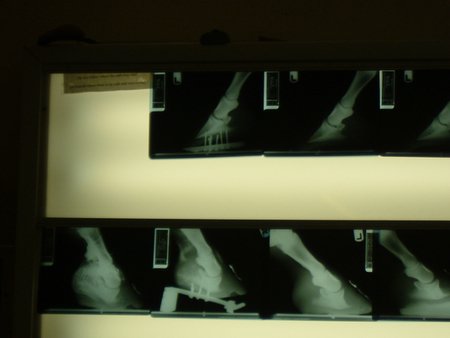Site Menu:
| This is an archived Horseadvice.com Discussion. The parent article and menus are available on the navigation menu below: |
| HorseAdvice.com » Diseases of Horses » Lameness » Diseases of the Lower Limb » Degenerative Suspensory Ligament Desmitis (DSLD) » |
| Discussion on DSLD and Patten Shoes | |
| Author | Message |
| Member: Lilly |
Posted on Wednesday, Feb 8, 2006 - 9:34 pm: Hi Dr.O,I hope I am not driving you crazy with all of my talk about DSLD, but here I go again. Last week I had the vet come out and do some radiographs of Sebastian's hind legs. I wanted to get a good look at his sesamoids and get some hoof x-rays for a podiatry clinic. We had a lot of trouble getting Sebastian to stand on the blocks for the hoof x-rays. Because of the pain in his back legs, he wanted to have one hoof cocked while the other was flat. He had a very hard time standing on the two separate blocks. We ended up taking x-rays with his toe balanced on the block. The vet thought they were a complete wash but Dr.Floyd, the podiatrist teaching the clinic, thought they were very helpful. Dr.Floyd pointed out that Sebatian's digital allignment looks pretty good in the x-ray and theorizes that is why he stands with his foot cocked. He is trying to put his bones in correct allignment. Dr.Floyd also believes that if Sebastian is put in Patten shoes that are approx 80mm high (80mm determined from x-ray)that he would be more comfortable and the suspensory ligament will heal some. The Patten shoe would be lowered gradually until he is either in flat shoes or a low wedge. My concern is that Sebastian's case has been seen by a lot of vets and no one has shown a glimmer of hope for him. Patten shoes have never been recommended by anyone other than Dr.Floyd. I have a very close friend who had a thoroughbred diagnosed with DSLD at 17 years old. Her horse was fitted with Patten shoes and his condition improved greatly. He lived to be 25 and died of heart failure. So, could you please look at his x-ray and tell me if Patten shoes make sense? Thank you. At this time I only have an x-ray for one leg. The other one didn't turn out. Ann 
|
| Moderator: DrO |
Posted on Thursday, Feb 9, 2006 - 9:38 am: Ann I really cannot tell from a single radiograph if a particular shoe will make sense for this horse. I do think that if Dr. Floyd has made those statements from the above radiographs alone he has a better eye than me. I cannot ascertain the alignment of the digital bones from above or from where the pain is coming from. The use of corrective or therapeutic shoes should only be made after a careful and complete exam of the feet and legs.The above radiograph does help however with placement of the coffin bone within the hoof capsule and there appears to be a huge amount of sole making significant angle changes through trimming possible. Concerning shoeing and elevating the heels for suspensory disease, see Equine Diseases » Lameness » Diseases of the Lower Limb » Suspensory Desmitis, Strain, & Sprain. DrO |
| Member: Mrose |
Posted on Thursday, Feb 9, 2006 - 9:55 am: I am quite curious, what are Patten shoes? |
| Member: Lilly |
Posted on Thursday, Feb 9, 2006 - 1:49 pm: Sara,Patten shoes are elevated in the back. Sometimes special lifts are welded onto the back of the shoe. Sometimes metal plates are attached to the back in a stacked fashion to make it easier to gradually lower the shoe. Look at the picture I attached. On the bottom row of radiograph photos there is a Patten shoe. Do you see how it is elevated in the back and there is a little lip attached to the front of the shoe? 
|
| Member: Mrose |
Posted on Thursday, Feb 9, 2006 - 2:30 pm: Thanks, Ann. I've never seen one before. I've seen various wedges that are put on under the shoe, but not done this way with the shoe. |
| Member: Lilly |
Posted on Thursday, Feb 9, 2006 - 2:58 pm: Dr.O,You make an excellent point. I was actually thinking the same thing. I couldn't understand why the vet wasn't interested in more info about Sebastian. Not only do I have x-rays but I also have recent ultrasounds. In her defense though, everyone who has told me to stay away from Patten shoes has never seen my horse either - except for Dr.Kent Allen. I am not sure that Sebastian has as much sole as you think he does. If you look at the bottom of his foot you can just make out a cup. It is hard to tell where it ends but it may run the full lenght of the coffin bone. I am getting new x-rays next week, hopefully with Sebastian's feet flat on the blocks. At that time I will make sure the feet are clean so that the x-rays are easier to read. What are thoughts on the whole theory of Patten shoes taking the stress off the suspensory ligament so that it can heal? That is the one thing that I am most curious about. I have read that horses with DSLD do not repair their ligaments correctly after an injury. Apparently the collagen fibers are replaced with a cartilage like material. Sometimes the suspensory ligaments are soft like jello in DSLD horse and sometimes they are hard and thick (observations made after necropsy). My thought is that the suspensory ligament will heal some and become shorter but that it won't be healed correctly and he still won't be sound. |
| Moderator: DrO |
Posted on Friday, Feb 10, 2006 - 6:59 am: Ann we cover the effects of elevated heels on the forces on the suspensory ligament in the article on suspensory desmitis. Considering what is currently known about this, I agree that this form of treatment is unlikely to cure or even slow down the progress of DSLD, but I don't know of any studies.DrO |
| Member: Wolfydoc |
Posted on Friday, Mar 17, 2006 - 1:17 am: DrO,I read the Susp. Desmitis article looking for detailed info on shoeing but there is only a few sentences unless I'm missing it. Do you have sources I can check out regarding the studies on elevating heels? I also am having a hard time understanding how some farriers can say that Peruvians MUST be shod to provide "support" so they will be less likely to develop DSLD. Or, when they do have it already, you must provide support with a shoe (and the farrier who told my friend this is only putting regular keg shoes on). I just can't visualize in my head why this would have any effect at all, especially if it's a flat shoe. It seems the trimming itself would be more likely to have an effect, but a metal shoe on the bottom of the hoof would have none at all; to the contrary, it would only add the possibilities of hoof problems such as contraction, weak walls, excessive growth, thin soles, etc. on top of the existing DSLD problem. What say ye? Cindy Nielsen |
| Moderator: DrO |
Posted on Friday, Mar 17, 2006 - 9:37 am: I say ye make perfect sense, shoeing as you describe will provide no benefit at all and there are no shoeing techniques that have been shown to prevent DSLD.I am uncertain if you are saying the recommendations for trimming are unclear or that you would like to see the reference on which the recommendation is made. I will place the reference for the effects of elevating the heels on the suspensory in the article today and if you still have questions post them in the discussion section of that article. DrO |
| Member: Lilly |
Posted on Friday, Mar 17, 2006 - 6:52 pm: Cindy,Here is an interesting article that was printed in Eqqus magazine about my friend's horse. He was a thoroughbred who was fitted with Patten shoes. If you do a search using the vet's name and dsld, you will find more interesting DSLD info. https://www.horseshoes.com/anatomy/esad/articles/albertssecondchance/albertssecon dchance.htm |
| Moderator: DrO |
Posted on Saturday, Mar 18, 2006 - 9:21 am: An interesting case history Ann and considering the lack of other good treatment options I would give it a try: perhaps the amount of strain as described in the research is not the only story. I always liked elevating the heels remarkably by by welding a single piece of a short length of pipe across the heels. It is cheap, easy to find, comes in a number of widths, easy to weld, and provides surprisingly good traction for the horse.DrO |
Horseadvice.com
is The Horseman's Advisor
Helping Thousands of Equestrians, Farriers, and Veterinarians Every Day
All rights reserved, © 1997 -
is The Horseman's Advisor
Helping Thousands of Equestrians, Farriers, and Veterinarians Every Day
All rights reserved, © 1997 -
